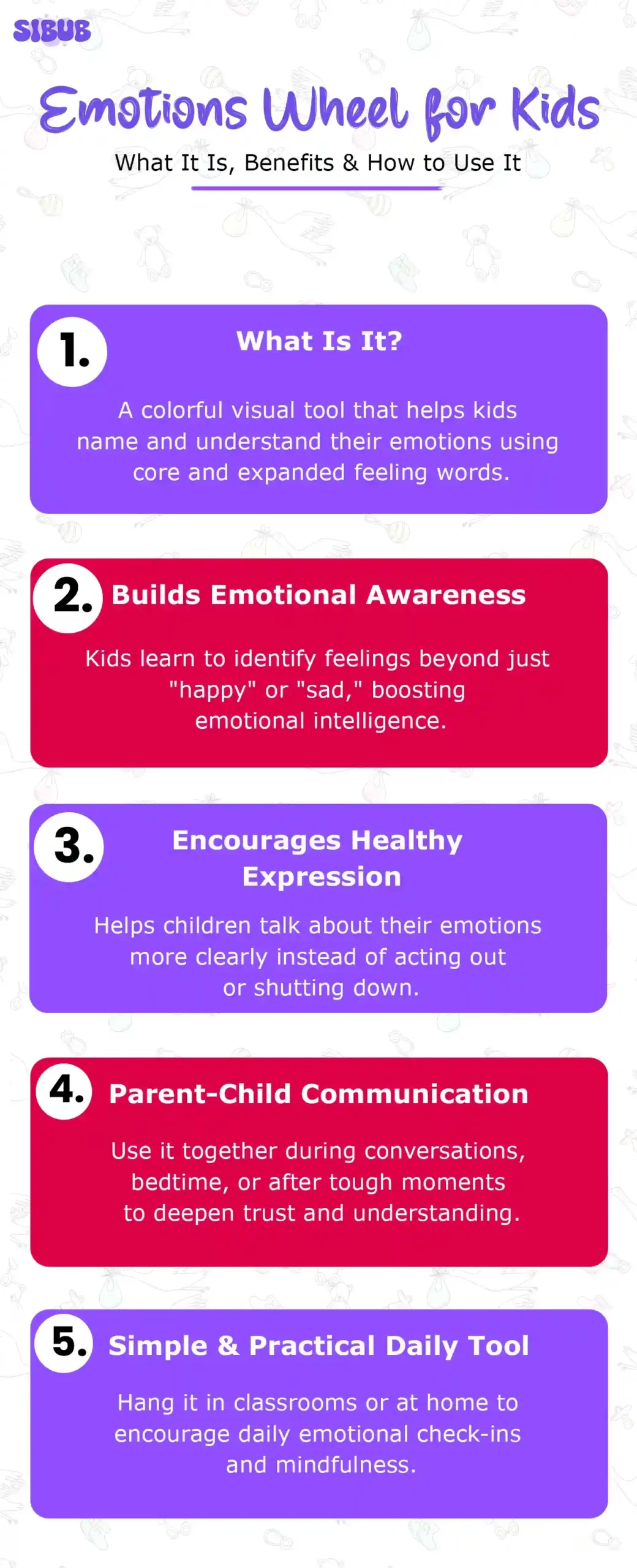Every mother must have had a moment where their child says they’re “fine,” but you just know they’re not. Can you relate? The truth is, kids feel a lot. Joy, fear, confusion, and everything in between, but putting a name to those feelings? Not so easy. That’s where an emotions wheel comes in to rescue.
This is a visual and colorful tool designed to help children or even adults recognize, understand, and name their emotions. Tools like these not only help, but they can sometimes change lives.
Let us examine in detail what an emotion wheel for kids is and its importance, as well as how to use it.
What is an Emotions Wheel?
It can be said that the emotions wheel is a feeling colored map. The Emotions Wheel enables kids to progress from calling their feelings happy and sad to actually identifying their emotions – feeling frustration, awe, or even anticipation.
The Original version is named Plutchik’s Wheel of Emotions, which was created by psychologist Robert Plutchik. His model includes eight basic emotions, which are joy, sadness, anger, fear, surprise, trust, disgust, and anticipation. From those emotions, there can be subdivisions into mild and intense forms.

But don’t worry, there are kid-friendly versions too. These simplify the language and visuals to make emotional understanding easier for younger minds. Some even call it the feelings wheel for kids, mood wheel, or feel wheel, but it all serves the same purpose.
Why do kids have problems understanding and dealing with emotions?
As with adults, children face challenges dealing with both negative and positive emotions. More often than not, they may cry or misbehave or shut down entirely, due to their feelings being too complex for them to articulate.
Regardless of the chosen activity, children undergo a spectrum of emotions. However, they lack the control and understanding to make sense of what is happening.
In addition to this, there is another issue. To manage emotions such as anger, frustration, or sadness, children need to be able to identify those feelings. Without the proper identification skills, unpleasant feelings become impossible to manage.
This is where children can harness the most benefits in using the feelings wheel. The wheel not only assists children with labeling their emotions provides vocabulary enhancement as well. To put it simply, the feelings wheel allows children to articulate their emotions and feel heard.
Must Read: Acetaminophen for Fever and Pain in Children: Safe Dosing and Tips for Parents
The Colorful Breakdown: The Emotion Color Wheel
Each emotion on the emotion color wheel is represented by a unique color. The shades tell you how intense the emotion is.
- Red might mean anger.
- Light pink could be an annoyance.
- Dark red? That’s rage.
This visual approach helps children literally “see” what they’re feeling. Plus, kids are naturally drawn to colors; it’s like emotional learning meets art class.
Benefits of Using the Emotion Wheel for Kids

Boosts Emotional Vocabulary
Apart from allowing children to learn new, advanced words, the wheel of emotions can also expose learners to words that will broaden their emotional vocabulary beyond the basic circle. Simple emotional terms such as embarrassed, curious, and apprehensive etc. can be taught to them to be used in their daily lives.
Promotes Self-Awareness
Emotional responses trigger a lot of behaviors. Identifying what a child feels enables them to develop a better understanding of themselves. This self-awareness can help cope with emotional responses in dealing with certain patterns and triggers.
Explore: 45 Growth Mindset Mantras to Strengthen Your Mental Health Daily
Supports Emotional Regulation
You can’t manage what you don’t understand. This pause is critical for learning how to respond, rather than react.
One cannot understand the complex emotion of anger without having prior knowledge of it. The feelings wheel helps kids pause and think about what they’re feeling. Pausing in advance can enable them to learn how they should respond in a particular situation, instead f an abrupt reaction.
Encourages Healthy Expression
Children learn ways to convey their feelings rather than screaming them out or suppressing them. Initially, they may just point at ‘frustrated’ on an emotional wheel chart, but eventually, they are able to vocalize it.
Fosters Empathy
Understanding their own feelings helps children recognize that others have emotions too. The wheel of emotion becomes a tool for social growth, not just self-regulation.

How to Use the Feelings Wheel with Kids
It’s not about pulling it out only during meltdowns. The feelings wheel for kids is best used before emotions get overwhelming.
Here are simple ways to make the most of it:
Use it Daily
Create a routine. After school or before bedtime, ask:
“Can you show me how you’re feeling on the emotion wheel today?”
This daily check-in helps normalize emotional talk.
Name, Don’t Judge
No emotion is “bad.” If your child points to jealousy or anger, say something like:
“That’s okay. We all feel that way sometimes.”
Labeling without judgment builds trust.
Find the Triggers
Let’s say your child picks nervous from the wheel of emotion. Ask:
“When did you start feeling that way today?” Understanding what caused the emotion helps you support them better.
Discover: Top Benefits of Summer Camp for Kids
Teach the Scale
Show kids how one emotion can have different strengths. For example:
- Annoyed (mild)
- Angry (moderate)
- Rage (intense)
This teaches emotional nuance.
Using the Emotions Wheel to Understand Others
The feelings wheel isn’t just a self-reflection tool. It also helps kids understand classmates, friends, and family.
Improve Communication
If a sibling is snapping or a friend is distant, help your child explore the possible emotions behind those behaviors.
Maybe someone’s acting out of sadness, not meanness.
Ask:
“What do you think they might be feeling? Can you find it on the mood wheel?”
This opens up empathy and understanding.
Emotion Wheel Activities for Kids
Want to make it fun? Try these:
Color Your Emotions
Give your child a blank color wheel of emotions and let them color-code it based on how they feel that day.
Emotion Mix & Match
Mix two primary emotions and see what you get:
- Anger + Anticipation = Aggressiveness
- Fear + Surprise = Awe
This helps kids understand that feelings are complex and can combine.
Storytime Feelings
While reading a book, pause and ask:
“How do you think the character feels right now? Let’s check the emotional wheel chart.”
For Educators and Counselors
The feel wheel aligns with emotional well-being goals across various school curriculums:
- England (RHSE): Teaches the range and scale of emotions.
- Wales (Health & Wellbeing): Explores how emotions change with experiences.
- Scotland (Health & Wellbeing): Links feelings to behaviors.
- Northern Ireland (PDMU): Builds self-awareness and emotional understanding.
Whether you’re a teacher, counselor, or school nurse, the emotions wheel is a great addition to your emotional literacy toolkit.
Using the Emotion Wheel at Home
Consistency is key.
Place the feelings wheel somewhere visible; on the fridge, bedroom wall, or homework station. Make it part of your family language.
You don’t need to make it a big deal. Sometimes, a simple:
“I’m feeling tired and a bit anxious today. I found it on the wheel.”
…can model emotional openness and encourage your child to do the same.
Tips for Parents
- Be patient. Kids won’t master this overnight.
- Don’t correct. If they point to “sad” when you think it’s “mad,” explore it, don’t dismiss it.
- Model it. Use the emotion wheel yourself. Kids learn by example.
When to Seek Extra Support
If your child struggles to express emotions, or if their feelings seem overwhelming often, it’s okay to seek help.
Using a feelings wheel for kids is a great start, but sometimes professional support is the next step. Therapists and counselors often use similar tools and can guide your child deeper into emotional understanding.
Visit: Using OTC Drugs Runny Nose Medicine to Treat Cold
Ultimately, A Small Tool With Big Impact
The emotions wheel is more than a colorful chart. It’s a bridge. A tool that connects thoughts to feelings, chaos to calm, and confusion to clarity.
For kids, learning to name and understand their emotions isn’t just helpful, it’s empowering. It gives them a voice. And that’s something every child deserves.
So go ahead, print out the feelings wheel, hang it up, and start a conversation. You might be surprised at what your child is ready to share and ultimately improve his/her emotional wellness.
